We reached the end of July with the weather cooler, mostly cloudy, and with rather unpredictable thunder and rain showers here and there over western Britain. However, very little of the rain found its way into our main rivers, and fishing of most types consequently remained quite tough. Rather than selecting just the big catches from the returns, I’m going make an effort to highlight some of the memorable descriptions. Here’s a good one. You can camp by the river at Penpont House these days, and AL from London managed 5 trout on a difficult evening spent fishing a shrunken Usk. After a reflective glass of whisky in his tent – good idea that – he returned to the river and took a final brown trout of a pound, casting to the sound of the rise in darkness. For me, that would have earned a second glass. He had another half dozen trout from Pantyscallog the next day.
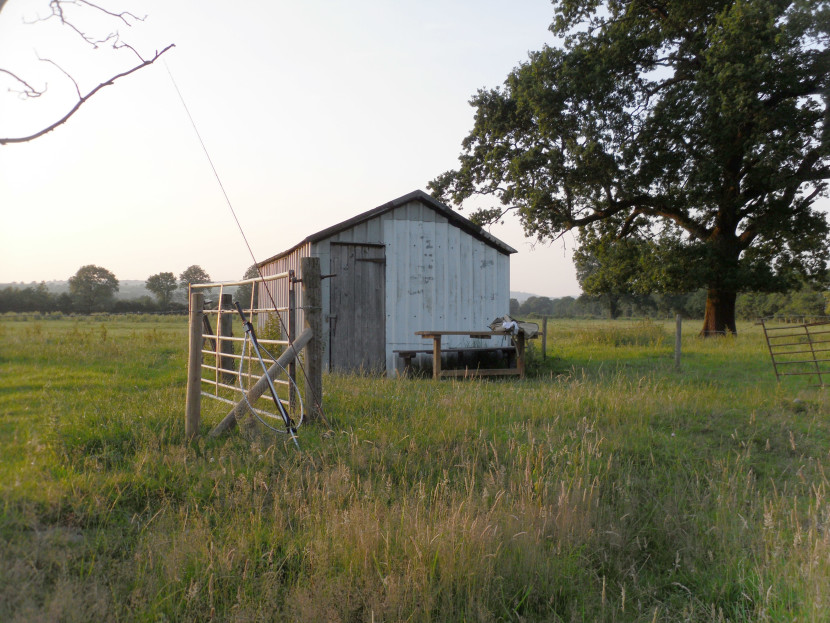 Llangadog Crewil Pool hut
Llangadog Crewil Pool hut NB from Chelmsford with his son had taken night fishing tickets at Llangadog and referred to the “large pool with a hut” lower down the beat. This is the famous Crewil Pool, one of the best holding pools for sewin on the Middle Towy and the pride of the Llangadog club. By 1.30 they had experienced nothing more than a couple of tentative pulls, so they called it a night. However, the following evening they were back on the same pool and saw local club anglers catch three before midnight. Their turn came next and NB’s son using a two fly set up caught a fine hen sewin estimated at 5-6 pounds. Unfortunately the rest of the night didn’t go so well. A bat was accidentally hooked during casting; NB’s son tried to unhook it and was bitten, and spent most of the next day in A&E undergoing anti-rabies injections. I have mentioned this before; it’s unusual to be bitten by a bat in this country, but the bite can potentially make you very ill indeed, so do not try to handle them. Sorry to hear about that, NB, but congratulations on the fish.
JA from Leominster fished Whittern on the 30th, took 7 trout and saw enough rain falling locally to make the Arrow colour slightly. TD from Pembrokeshire fished Llyn Bugeilyn the following day and had no less than 35 trout on buzzer patterns. DR from Abergavenny fished the Honddu at Lower Henllan and caught 7 on big dries such as Klinkhammers and sedge patterns. On the same day we had a lot of good reports from Llwyn On, including LM from Merthyr who caught half a dozen on a cool, cloudy morning. DB from Swansea fished the Usk Reservoir on the 2nd August and due to a “gammy leg” could not avoid the picknickers, stone throwers, canoeists etc thronging part of the shore. Nevertheless, he caught 4 trout on Olive and Ginger Snatchers fished about 12 inches below the surface and thoroughly enjoyed himself. On the 2nd RS from Llanfairpwll…er….you know, that place English people can’t pronounce….ticked us off about our Welsh spelling. He and a friend fished Cambrian AA water Llyn Conglog, not “Llyn Conlog” as the feedback system had been auto-populated. They caught just one trout there, but 6 more from Llyn Corsiog. TH from Brecon had 4 trout and 17 grayling from Llangoed and Lower Llanstephan. Meanwhile MO from Bromley had 77 chub from Sugwas Court, a catch which he described as “…not the best.” Presumably barbel had been hoped for. On the 4th we had news of a double-figure sewin caught at Abercothi, the Towy being low of course, but relatively cold. JE from Yarpole with a friend visited Pond Glandwgan, where fishing was difficult, but then “…we were both treated to the sight of a trout passing both of us about ten feet away with his back and dorsal fin clear of the water grazing on hatching midges. We both estimated him to be in the five to six pounds weight range.” Needless to say, they couldn’t get it to take, as is usually the way with fish right up on the surface, a position from which they can see almost nothing. MO from Bromley was in action again on the 5th at Caradoc, from where he reported 3 barbel and 8 chub, remarking laconically and rather mysteriously: “You get what you paid for.” That hasn’t always been my experience in life, but never mind. On the 6th, MG from Hereford caught a dozen Lugg grayling at Eyton and had compliments for the fishing, but not the access. I presume he was talking about the upper part of the beat, which has always been a bit of a jungle, but balsam bashing does pay off. Eyton has some excellent grayling if you can reach them. AL from Rugeley had 8 trout on a Gold-head Hare’s Ear nymph, fishing the top of the Wye at Upper Clochfaen. On the main river trout and grayling could be taken in the fast water at the heads of pools, but many carried a lot of freshwater lice as is usual enough in drought conditions. The coarse fishers on the middle and lower Wye were doing quite well by now with the barbel and chub, but many were the complaints about the state of the river, the algal slime everywhere and lack of ranunculous weed. About this time the dreaded pea soup green stain came back once more to the lower Wye. The problems with the main Wye are now nationally known and the arguments about agricultural pollution are well rehearsed. For once anglers, wild swimmers and even canoeists might be singing from the same hymn sheet in the search for water purity.
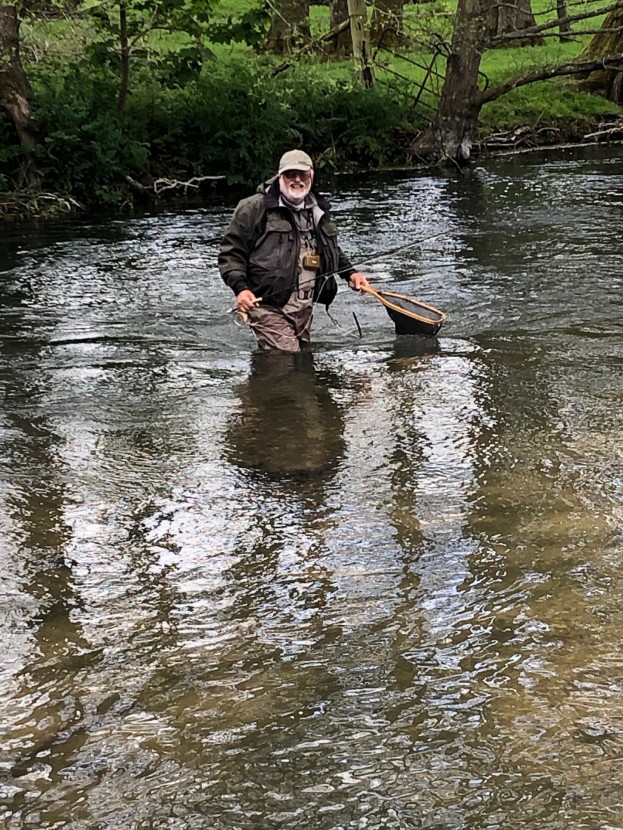 One on the dry fly
One on the dry fly 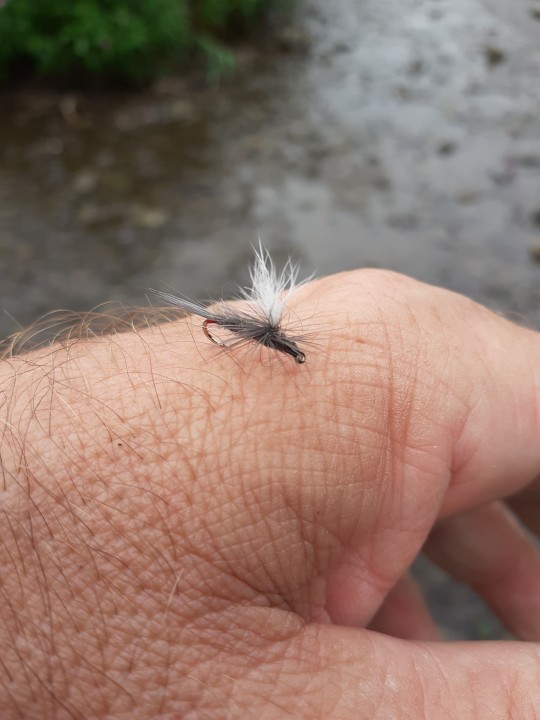 Parachute Iron Blue - JA from Leominster
Parachute Iron Blue - JA from Leominster Rain arrived on the 7th and there was a slight lift in the levels. Salmon always seem to know what is coming and I saw a few grilse showing in the Erwood area, nosing up into the fast runs. The showers were intermittent and unpredictable, but must have been heavy enough in the Cambrian Mountains to produce an 18 inch rise the following day. Lyn Davies from Swansea fished at Ty Newydd with the level rising and a lot of colour in the water, found himself slightly restricted in wading, but managed 7 trout and 2 grayling, mostly with spiders. He noted the somewhat hazardous car parking arrangement at Ty Newydd; the private car park itself is excellent once you are inside, but the entrance is close to a blind summit on the A470 with its fast-moving traffic and you need to be very alert as you drive out. Finding the entrance itself is also a problem, as the hedge has now over-grown and hidden the flanking wooden fences. Somebody remarked that a prominent traffic mirror on a post might help with both problems. The upper Wye continued high for trout fishing, but not impossibly so, although the stain of colour remained for a while. JA from Leominster recorded 3 good trout to an estimated 15 inches from the Arrow at Titley on the 9th, taken on dry flies. JE from New Malden used a dry Parachute Adams and an Iron Blue to take 8 trout from Aberedw, also to a very creditable 15 inches. CR from Aberdare caught 20 trout from the Usk Reservoir.
There had still been no real flood to clear the rivers out. Colour remained in the Wye and game fishing was less good than the refreshing showers had led us to hope. Several salmon, the first in a month, were taken by spinning through the green soup down at Wyesham. In contrast coarse fishermen seemed to be having a wonderful time on the middle Wye. RD from Hillingdon fished Fownhope No 5 and wrote: “Wow! What a day! Went roving and had 10 barbel to 10 pounds and 25 chub to 6 pounds. Not expecting that after all the reports of river in bad condition.” In fact during this period we had reports of many large catches of barbel and chub which seemed to be standing up to the conditions well. Meanwhile SA from Leominster recorded 6 trout and 6 grayling from Lyepole on the 14th, while BR from Tewkesbury got a Wye salmon of 12 pounds from the Millstream at the Rectory. Again this was the first salmon from the upper river in quite a while. RW from Hereford caught 4 trout and 6 grayling up at Dolgau. JM from Bristol fishing the Dean and Chapter Pool remarked that, for now, he is switching from salmon to barbel fishing. We may see some more of that while there are problems with the salmon fishing. BP from Llandovery had 11 trout from the Usk Reservoir, but had complaints to make about the condition of the access road. SC from Rhondda had no less than 20 trout from Llwyn On. TH from Brecon recorded 17 grayling from Llangoed and Lower Llanstephan on the 16th, while on the following day DR from Abergavenny took 6 trout and 2 grayling from Craig Llyn. The wading isn’t always easy here, but he had nothing but praise for the access arrangements. HJ from Bridgend was up at Llyn Bugeilyn, where he took 20 trout, mostly on Bibio and Bibio Sedgehog – a wise choice of patterns for this kind of upland lake. DC from West Herefordshire (that’s our Dave Collins, the Man of Moccas) put in a session at Builth Wells and used a small Duck’s Dun for 3 trout and 14 grayling to 17 inches, which would have been a proper 2 pounder.
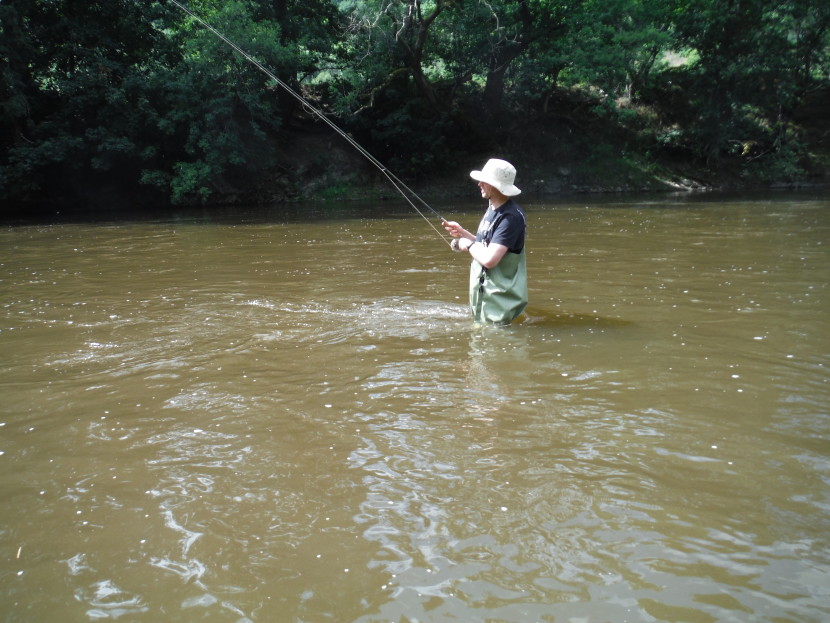 Coloured water on the upper Wye
Coloured water on the upper Wye 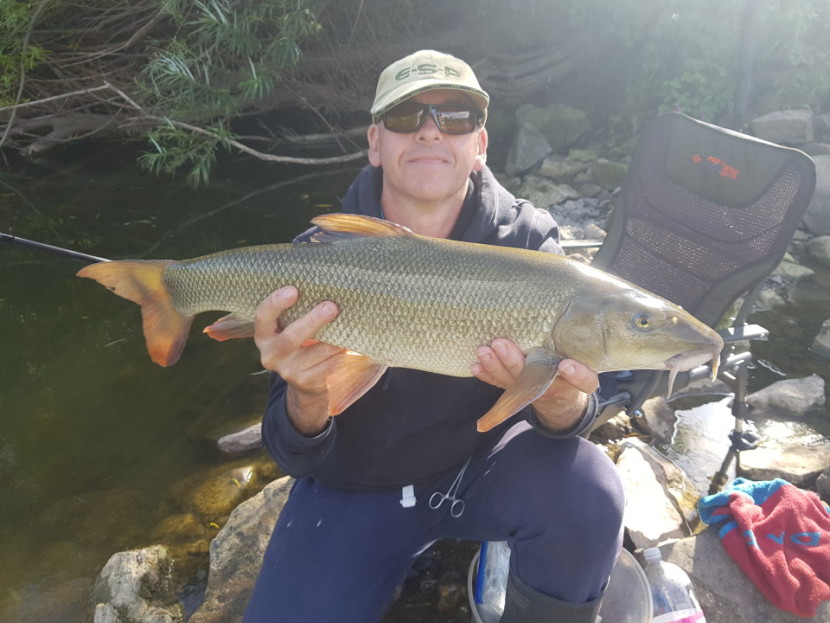 Handsome Thomas Wood barbel - JS from Bristol
Handsome Thomas Wood barbel - JS from Bristol The 21st was a day of heavy showers, enough to raise the upper Wye by a few inches this time. RW from Hereford had 10 trout and 5 grayling from Doldowlod, taking advantage of the fresher conditions. At once salmon began to take notice on the upper river also; Nyth and Tyrcelyn reported 4 fish to 13 pounds for one rod using a tiny Cascade at the beginning of the rise. On the 23rd the same beat had another of 16 pounds, again on a size 14 Cascade, and which apparently went off like a rocket. The rain didn’t last, high pressure returned and warm, dull days with very little wind followed. Water levels quickly fell again. Lyn Davies called me on his way home after an interesting evening on the Towy at Llandeilo. He had been fishing after work, nymphing with light tackle for brown trout in low, clear water, when a sewin of 1.5 pounds grabbed the dropper. He was very pleased with that, but half an hour later, with dusk coming on fast, another of about 5 pounds grabbed one of the flies. Nothing causes chaos like a freshly hooked sewin and this one went on to do just that for a while. Finally Lyn managed to persuade it into a small brown trout net; however it freed itself by jumping out while a photograph was being attempted. Lyn will be the first to admit this was not traditional Welsh sea trout fishing in the recommended fashion, but it’s interesting how often they will fall for a tiny nymph.
PW from Billingshurst with 3 companions while fishing for salmon at the Rectory were troubled by trespassing teenagers drifting through the beat on lilos and canoes. Dave Collins again found fish at Abernant rising right through the day until 6 o’clock. Pale wateries and a few sedges were coming off and he accounted for 10 trout and 27 grayling on small dry flies. That sounds like a very fine day, more like autumn fishing in fact and I’m guessing that moderate temperature and cloud cover may have helped? On the 26th BR from Tewkesbury used a very small Sunray Shadow to take a 10 pounds coloured hen salmon from the Rectory Neck. That is an exciting and likely place to take a salmon under low water conditions, a sort of upper annexe to the main pool which you fish from an exposed ledge of rock. I remember hooking a big one there which just backed slowly down shaking its head to the depths of the Rectory Pool proper before coming off. On the 26th DC from Telford made his way up to Llyn Bugeilyn, appreciated the repaired access road (although he walked the 5 miles in and out) and caught 9 trout on small dry flies. Apparently there was a rare fall of flying ants and fish were rising everywhere. On the 30th ZW from London was after salmon at Gromaine, but instead caught a 74 cm barbel which took what looks like a largish tube fly. So much for August, a dry month, but one during which there was not much risk of being sun-burned.
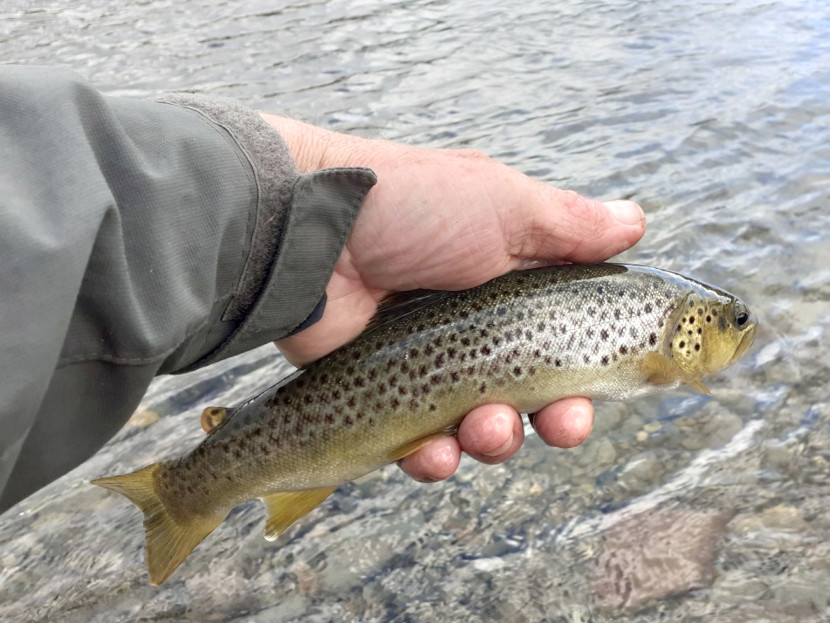 Clochfaen trout - AL from Rugeley
Clochfaen trout - AL from Rugeley 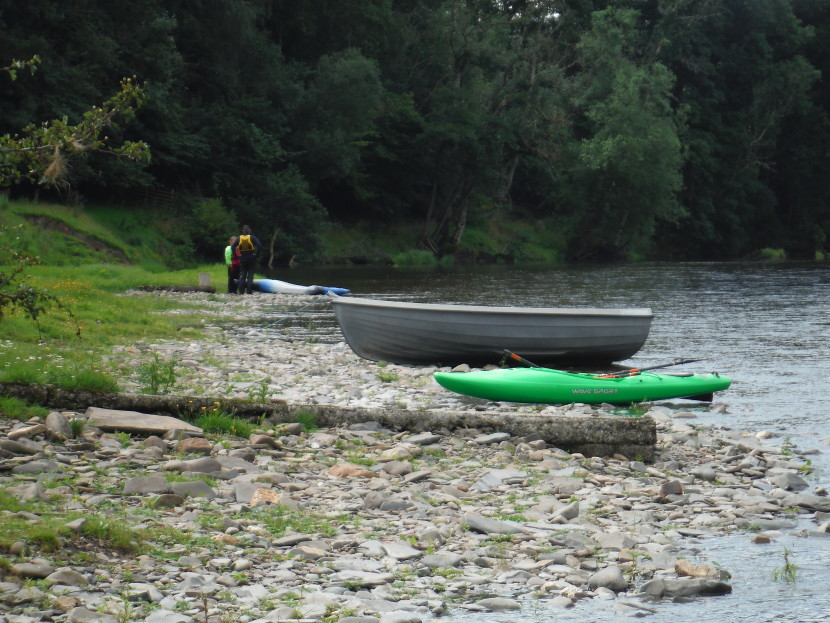 Canoeists trespassing at Abernant - an almost daily occurrence this year.
Canoeists trespassing at Abernant - an almost daily occurrence this year. “The boys are back in town” somebody quipped the other day. He was referring to the fact that now, almost twenty years on from 9/11, the Taliban are back in Kabul and indeed almost everywhere else in Afghanistan. It wasn’t much of a joke. Relatives of those British soldiers who lost their lives while serving in that country during the last twenty years must be feeling more than usually depressed at the moment. President Biden in Washington made an extraordinary and unilateral decision to declare a victory in Afghanistan and pull out American troops. This left London little choice but to follow suit after unsuccessful efforts had been made to persuade other NATO nations to remain alongside us. The fragile governmental structures which the international community worked so hard to create seemed to collapse with extraordinary speed. The Afghan soldiers we trained slipped into civilian clothes and melted away, hoping to escape retribution in the bad times coming.
While it happened the peace conference in Doha between the Taliban and the existing Afghan government continued, for what it was worth, as a sort of parallel process to the military conflict. It looked more and more like a deliberate smokescreen. As facts on the ground changed, the Taliban demands at the conference grew ever stronger and one wondered how long the present Afghan government would survive. And the new facts on the ground by the beginning of August were that the Taliban already controlled at least 50% of Afghan districts. At first the Taliban did not try to take cities, but instead occupied the vitally important international border crossings by which support for the Government might come. Herat in the West was by July already cut off from Iran as the Taliban had taken the Islam Qala / Tayabad border crossing. Do not underestimate the negative effect of this blockade. The southern branch of the Silk Road still crosses Afghanistan and Iran while the movement of those big Russian 6WD trucks across the deserts of Central Asia are as internationally important as the camel caravans of past centuries. Taxation on trucks and the movement of goods is about the only taxation there is in Afghanistan. Islam Qala is said to be worth 20 million dollars a month in transit fees; now the Taliban were collecting them.
As we reached August the attacks turned against the cities, Lashkagar, Kandahar and then Herat city, where half a million people waited in suspense. War in the open desert is largely a matter for the combatants, but fighting house to house inside cities can be a tough and bloody business, with the civilian population invariably the main sufferers. Herat was soon cut off in all directions and even the road to the airport was blocked. Taliban outposts were becoming visible in the suburbs and the UN compound was attacked. Columns of refugees began to appear on the roads in many areas. Twenty years ago, while I lived and worked up-country in Ghor province, the great oasis city of Herat was my regional centre and I visited it occasionally, stayed in my organisation’s team house and ate in the UN guest house. While for the most part I haven’t kept up with people I knew then, the latest news from Afghanistan was beginning to bring certain names and faces uncomfortably back into focus. For now I have no way of contacting old Herati friends.
The Kabul Government quickly found it could not rely on regular army units without international troops present, so sent what elite forces they could spare to Mazar i Sharif, Kandahar and all the regional capitals. Now the old Mujahadin commanders, some of them veterans in their seventies who once fought the invading Soviet Union, began to emerge in what seemed to be the country’s hour of need. On the news reports I once more saw Ismail Khan, the commander who came back to Herat from Iran when the Taliban collapsed in 2002, and who was now deploying his private militia alongside government troops to defend the city. Nobody’s idea of an Afghan war lord, he is a diminutive, smiling figure, looking a little like the late angling writer Bernard Venables, his face surrounded by a halo of hair and beard gone quite white since I met him last. Back in 2002 he styled himself as “Emir of Western Afghanistan” before Kabul and the Americans reined him in a bit and he settled for plain “Governor.” He has maintained a private army ever since fighting the Russians in his mid-twenties, but his back was surely against the wall now. Initially and with his encouragement something like a popular uprising of Herati citizens under arms did push the Taliban back from the airport, which allowed reinforcement by some (British-trained) Afghan special forces from Kabul. Meanwhile the Uzbek General Dostum, a man with a fearsome reputation, owner of a private jet and who even issued his own currency at one stage, was seen again organising the defence of his old northern fiefdom of Mazar I Sharif.
Events followed each other with alarming speed. Every day provincial capitals fell one after another: Balkh, birthplace of the Islamic poet Rumi, Faizabad, then Farah, capital of the neighbouring province to Herat. All flights abroad were booked as the wealthy got out. Hundreds of displaced people blocking the roads became thousands, then tens of thousands. There was little sign of humanitarian provision, so they camped in the streets of neighbouring cities. The head of the Afghan Army was replaced. The US President made a statement that he did not regret the decision to pull out American troops, but would be providing assistance “over the horizon.” That can mean anything from diplomatic pressure to air strikes. The Chief of the British Defence Staff stated rather hopelessly that this was a time for Afghans to show some unity and stick together. The UN warned of a looming humanitarian catastrophe. The EU was already discussing what should be done if and when new waves of Afghan refugees began to arrive on its eastern borders. Turkey made an early statement that, having taken 5 million displaced Syrians, the country was not prepared to host more Afghans, either for money or any other reason.
Herat fell on 12th August; Ismail Khan was reportedly now a Taliban prisoner and Iran was demanding from the Taliban guarantees for the safety of its consulate staff. Afghanistan’s second city of Kandahar fell one day later. Over the high passes into Baghdis, the capture of Qala i Naw turned the rest of the West into a solid Taliban wall. Several provincial governors were arrested by the Kabul government for surrendering without a fight. The US announced they were sending 3,000 Marines back in to protect the evacuation of American citizens, contractors and embassy staff. The UK similarly sent 600 force protection troops to evacuate British NGO personnel, interpreters and others. There was now talk of moving embassies in Kabul to the more easily defended airport. Germany threatened to cut off aid. Defence Secretary Ben Wallace made a minatory statement that if the Taliban re-established links to Al Qaeda, Britain would once more invade and presumably stay. By this time it hardly seemed a credible threat. New Taliban fighters were pouring over the border from Pakistan. The speed of it all was such that one could imagine scenes of panic before too long as the last helicopters were leaving the roof of the US Embassy in Kabul. In fact the comparison with Saigon in 1975 was inevitable; like the Vietcong before them, all the Taliban had needed to do was wait the foreigners out.
On the evening of the 13th Boris Johnson called a COBRA meeting to discuss Afghanistan. The usual format of the military briefing given to such meetings goes: analysis of the crisis; possible responses available; line to take with the press. I can’t imagine that much comfort was to be had under any of those headings. In fact the UK had already decided there were now no outright military options, but only diplomatic ones. One exception would have been the planning of a NEO, which is military-speak for a Non-combatant Evacuation Operation.
Mazar I Sharif fell on the 14th; it appeared that General Dostum had cut a deal with the Taliban. On the 15th Jalalabad fell, leaving Kabul isolated from Pakistan. Far from house to house fighting, the conquests of provincial capitals were becoming easier and easier. In most cases the Taliban had only to walk into the governor’s mansion, the police station and the radio station for resistance to disappear. Officials just went home. Initial estimates that Kabul would fall within 60 days were now being revised downwards. In fact it wouldn’t even take 6 days. The suburbs were already infiltrated and Taliban leaders were openly holding meetings inside the city. The capital was quiet, but smoke from burning documents was rising high above the US Embassy compound. It became apparent now that nobody was going to fight for Kabul. President Ashraf Ghani fled to Uzbekistan, citing a need to avoid further bloodshed. Shortly after we saw film of Taliban fighters inside the meeting room of the Presidential Palace. Veteran politicians Hamid Karzai and Abdullah Abdullah were said to be in the city talking to the Taliban, trying to negotiate a peaceful hand-over of power and the best terms they could manage. More Taliban fighters were seen parading in their vehicles on the streets while flying their white flag. They, and those NATO soldiers remaining, took care to avoid each other.
International embassy staff were evacuated to the airport and we began to understand why the incoming extra NATO troops were needed – merely to secure the airport during a massive evacuation operation which would include all internationals and as many as possible of those Afghans who had been accepted by receiving nations. Chinook helicopters went back and forth ferrying entitled personnel to the airport. Most of those hoping to be evacuated had to go by road and through a chain of Taliban checkpoints where they risked arrest. Before the airport perimeter was secured, for a time we saw scenes of horror – not helicopters leaving an embassy roof, but panicking crowds rushing the tarmac trying to board military aircraft, even while they accelerated towards take off. Several were killed falling from the undercarriage as planes lifted into the air. One heavy transport aircraft reached Qatar with an estimated 650 persons packed into the hold, several times its scheduled maximum, and there were human remains found in the wheel well. Shots were fired over heads to drive crowds back, and several people were killed at the airport gate, supposedly by the Taliban. Eventually it emerged that 20 civilians had died during the first week of evacuations, mostly crushed by panicking crowds.
As August went on the NEO became more efficient and thousands of persons per day were being air-lifted out by different NATO nations. Nevertheless, the situation continued extremely tense with near-hysterical crowds including many without any papers or evacuation entitlement queuing at the air-port gate having already passed Taliban checkpoints on the way in from the city. NATO was inside; the Taliban were outside. Intelligence assessments about the threat of an imminent ISIS (Khorasan branch) attack on the airport queues made the situation even more difficult and confused. With a dead-line set by agreement between the US and the Taliban without the involvement of NATO allies that American troops would be out of the country by 31st August, it became probable that many of those entitled were not going to be evacuated by the military air operation and might have to face the even greater risk of crossing land borders in the months and years to come. Unfortunately the intelligence reports about an imminent threat from ISIS proved to be exactly accurate. On the afternoon of the 26th a massive attack by a suicide bomb on the airport queues killed as many as 170 Afghans according to some sources and 13 American soldiers. ISIS(K) immediately claimed responsibility. A couple of days later, in what seemed an obvious sop to what was now a dismayed and highly critical US public, a Reaper drone launched in the Middle East killed an ISIS(K) commander driving in Nangarhar. CENTCOM reported another drone strike in Kabul on the 29th which apparently destroyed a vehicle filled with explosives being driven towards the airport. However, the following day it was claimed that a family of 10 including children had been killed by the explosion.
International recriminations had been under way since early August. For once the media turned away from the pandemic and started to pay attention to the unfolding tragedy. President Joe Biden was told by republican Mitch McConnell that he should “hang his head in shame.” He responded that he had not wanted to “hand this war on” to yet another American president. Unapologetic, he blamed the Afghan Army for failing to stand up for democracy and the nation. In the UK Boris Johnson recalled parliament. Tom Tugendhat, Chair of the Commons Foreign Affairs Committee, described it as “the biggest single disaster of foreign policy since Suez.” Defence Secretary Ben Wallace, who impressed as a troubled and decent man, cried for a moment during a radio interview while discussing our obligations to Afghans who had worked with British forces. It became apparent that although many thousands of entitled persons had been airlifted out (more than 15,000 vulnerable Afghans to the UK), the US was going to keep its promise to close the airport operation and remove its troops by 31st August, come what may. The Taliban needed the airport apparently. In London COBRA chaired by the PM met again after the ISIS attack to plan the last days of the NEO. Military flights carrying Afghan civilians wound down, although some 1,500 entitled still wanted to go. The remaining NATO flights to the end of the month would carry embassy staff and then soldiers and their equipment. Diplomatic efforts were proposed via the UN to demand that the Taliban continue to permit Afghan citizens who wish to leave to do so via commercial flights. The last US military flight left Kabul on the 30th, bringing to an end “America’s longest war” and followed by a night of celebratory fire from a victorious Taliban.
How did it all happen so fast? How did an estimated 60,000 Taliban defeat a (theoretical) 300,000 American equipped government troops in a matter of days. I write “theoretical” because some corrupt Afghan commanders were notorious for claiming salaries for non-existent soldiers. There has been some fighting of course and one could almost imagine that a brilliantly led military offensive by the Taliban has been sweeping across Afghanistan. In reality no such campaign has occurred. Instead there has been a reversal of what happened in the winter of 2001 after the 9/11 attacks, when the Northern Alliance, then rebelling against the established Taliban government in Kabul, suddenly found itself allied to the full power of NATO and with the US as its air force. After twenty years of international nation-building efforts, the situation went rapidly into reverse as Coalition forces left and the Northern Alliance in its turn found itself alone. Rather like a run on a bank, it was all a matter of confidence. What we saw during August was a rapid loss of faith in the Afghan Government, now without the backing of international forces, and local commanders and power holders once more rushing to change sides.
We might ask ourselves the interesting question of who has been helping the Taliban and in particular who has advised them on their public relations campaign? In this sense they have played their cards very well indeed – on timing, on choice of target, and some of the reassuring pronouncements they have made. So far, in Kabul the Taliban having been showing a softer, more human face, insisting that no vengeance is going to be taken against their opponents, that everybody including women and girls should continue to go to work and school, and that all citizens, particularly skilled ones, should remain in Afghanistan and work for the good of the country. My problem is that I find it hard to believe the Taliban has even been issued with a softer, more human face, and if they have it seems to be much less visible elsewhere in the country than it apparently is in Kabul. They still want an Islamic Emirate and they still want sharia law. Whether they are prepared to host international terrorists again is an open question.
Great powers have always tended to make the mistake of believing that superior military technology somehow will win for them in the end. The Victorians above all were supremely confident in this way:
Never forget that we have got,
The Maxim gun,
And they have not.
Military adventures in Afghanistan didn’t work out too well for the Victorian British – or the Soviet Russians – or now for the NATO coalition including the Americans and the British again. Today we are coming to recognize that in the long run what has come to be called asymmetric warfare actually works rather well for the weaker side, particularly in districts where the population supports the insurgents. To express the situation in another way, fanaticism is very difficult to defeat. Most of us in the western world don’t believe in a warrior’s paradise and if it can be avoided would prefer not to sacrifice our lives for another nation’s cause. In the case of Afghanistan, the Taliban are ready for both. Was all that blood and treasure spent in the 20 years since 9/11 totally wasted, apart from some benefits and freedoms provided, perhaps only temporarily, to those modernising influences in Afghan society? We now know that the decision to withdraw US troops was taken unilaterally by President Biden, apparently without consultation. The blindsided United Kingdom then worked hard to broker an agreement between remaining NATO members to keep an international military presence in Afghanistan, but ultimately failed. Without the Americans, it seemed, no NATO nation wished to be exposed alone in this task.
What happens now? Afghanistan will be left to the Taliban, which it should not be forgotten has quite wide support among the conservative Pashtun population, along with the NGOs and the UN agencies. I imagine it will look quite similar to the situation which greeted me when I first went to the Islamic Emirate of Afghanistan in the spring of 2001. There will almost certainly be pockets of resistance and a low-level civil war as the Northern Alliance fights back. In particular the Panjshir or “Five Lions” Valley, legendary birthplace of the Northern Alliance, remains free and is apparently determined to resist. Panjshiris are fiercely independent and anti-Taliban and their valley surrounded by 3,000 metre peaks is almost impregnable, although only 30 miles from Kabul. Their young leader Ahmed Massoud, who is Sandhurst-educated, is the son of the charismatic Ahmed Shah Massoud, revered as the Lion of the Panjshir before he was assassinated back in 2001. The Russians failed to take Panjshir as did the Taliban during their previous rule and that particular local conflict is likely to become a serious “freedom or death” struggle. Foreigners have always been fascinated by the romantic idea of the Panjshir and its outlaw leadership dynasty, but Massoud and his people will need some support from outside if they are to continue. The Taliban now are extraordinarily well armed, having taken over all the modern equipment, from Blackhawk helicopters to armoured Humvee fighting vehicles, which the Americans left for the now defunct Afghan Army.
Meanwhile the Taliban will of course say, as new governments do, that they are bringing freedom…in this case, freedom from foreign domination and the freedom to recreate an Islamic state. “I’m free all right,” a Tajik Afghan colleague muttered to me sarcastically back in the old Taliban days. “Free to grow my beard as long as I like.” Afghans are a conservative people, but most of those I knew appreciated the possibility to elect their leaders, wanted to see their daughters educated and didn’t wish to see a harsh interpretation of sharia law. Now they must be looking at their future with dread. People in Afghanistan are rarely generous to their enemies in victory and there is likely to be vengeance against those who supported the last government, served in the military or made any kind of public criticism of those now taking over. A lot of old scores are due to be settled. Already a familiar pattern is forming in areas which have fallen under Taliban control; former army members are ordered to register at police stations and report in regularly. There are stories of Taliban patrols armed with arrest lists involved in house to house searches. Carried by displaced civilians and recorded by human rights organisations, the reports of extra-judicial executions are already filtering out. At least one group of Afghan Army commandos ran out of ammunition and was massacred immediately after surrendering. We also have a report of a massacre of men of the Hazara minority, always hated by the Taliban as followers of the Shia version of Islam. I recall from twenty years ago an Afghan colleague in Ghor, a Tajik tribal leader who had once been provincial governor during the Soviet period. Every now and again a message would arrive from the Taliban authorities in Herat that he should come down to regulate his position with them. He sat tight in his own village, but I remember the grey look of fear on his face when the messages arrived. I wonder how he is feeling now.
An optimistic person might hope that the Taliban may have learned something during the 20 years in exile. I would like to think that when in power this time the Taliban might decide not to play deliberate host to Al Qaeda, ISIS or any other lunatic-jihadi international organisation with a philosophy more extreme than their own. The previous relationship with Al Qaeda turned out very badly for them. Unfortunately the intelligence reports say otherwise; the friendly relationship with Al Qaeda (although not with ISIS) remains strong. And the local franchise of ISIS certainly is active, as the airport bombings proved. For the benefit of those of us who thought the hard-line Taliban were quite enough to deal with, ISIS and particularly the Khorasan branch, strong now in Pakistan and Afghanistan and including many imprisoned for terrorist offences broken out of jail, is something much more extreme and unpleasant. The Taliban are parochial; they want to have an Islamic Emirate in Afghanistan but have no great ambition beyond the borders. ISIS are working hard to create a global franchise with a Caliphate stretching to every continent, and enforcing a much stricter version of sharia law than the Taliban do. At best they regard the Taliban as back-sliders and unreliable partners.
Another very slight ray of hope is that the Taliban will surely know, as they did before, that they cannot run Afghanistan alone. They, or anybody else trying to rule the poverty-stricken nation of Afghanistan, will need money. This can be a lever and Germany has already frozen aid money while the IMF have halted a large payment due in August. On the other hand, there are other sources of money and others with their own interests in investing in Afghanistan, including for the exploitation of minerals. China for example is a nation not known for insisting on linkages between investments and human rights standards. The UN and the NGOs have always played a vital role and, provided they speak up and hold their nerve, they could be a moderating influence. Previously the Taliban were persuaded by a talented UN Drugs Control officer (who offered some inducements regarding programme investment) to ban the growth of opium poppy. We were never so successful with the following Northern Alliance government and opium continued to flow, thus directly affecting the price of heroin on British streets, along with feeding the habits of an estimated 3 million addicts in Pakistan and Iran. It didn’t help me to learn that a major British NGO was content to be funding irrigation which was probably being used for growing poppy. The traders, owners of those hundreds of big Russian trucks, will want to see a normalisation of the situation and free flow of goods with neighbouring states. And the neighbours will continue to interfere in Afghan affairs; whatever they say publicly, elements in Pakistan will continue to support the Taliban (Taliban flags flew triumphantly in parts of Islamabad this month) while Iran will pursue its own interests. There is some faint hope that the intervention of the international community via the UN and the NGOs, speaking up for the rights of women and similar matters, may be able to modify the rule of the Taliban this time round. I can see no other reason to be cheerful.
At the same time, we need to be a little cautious as UN agencies and NGOs predict a looming humanitarian catastrophe apart from and beyond the displacement now occurring. They have a habit of making such predictions; I was surprised to hear a UN spokesman the other day telling us that more than half Afghan children are malnourished. Are there figures to support that? Twenty years ago in one of the most remote and backward provinces, during a drought, Taliban rule and after decades of civil war, we tested thousands of children with weight for height and upper arm measurements and found a malnutrition rate of less than 5%. If the situation has become so much worse during the last 20 years of western intervention, I’m sorry to hear it.
There will certainly be some soul-searching in NATO nations after this, not least about the behaviour of the senior partner. Some will point to the birth of the Taliban as one of a number of Mujahadin groups once clandestinely funded by the CIA to fight the Russian invasion and claim that “you reap what you sow.” Many will speak about the cruel effect of this defeat on ordinary Afghans in their daily lives. Others will state “we don’t do nation-building” (although in Afghanistan we certainly tried) and talk about our own self-interest. Jacob Rees-Mogg recently made the point that it is important to conjecture what might have happened in the wider world had we not intervened in Afghanistan after 9/11. Imagine a world in which the Taliban had continued to host Al Qaeda and continued to provide a platform for planning international terrorist attacks. How many more attacks would there have been over the last 20 years? Similarly John Bolton, former US national security adviser, deplored President Biden’s decision as “catastrophic” but pointed out that ex-President Trump had already sent a message to the peace talks that US troops would be leaving and would probably have made the same decision if still in power. He also emphasized that the US-led Coalition did not go into Afghanistan with the altruistic motive of improving civil rights there, but for reasons of self-interest and self-protection, to deny that same haven to international terrorists. In 20 years, that motivation and that need has not disappeared. He made the case that after World War II, NATO remained in Germany because of the need to protect against a perceived threat from the Soviet Union. American troops remained for 75 years and are in fact still based in Germany. So why has the defensive line in Afghanistan been abandoned?
For the British Army, I am sad to say, it looks to me like another defeat. Having spent years working in military liaison and having family connections and friendships with serving soldiers, it pains me much to write this. But the whole point of our slimmed down modern army is supposedly that it should move away from a war-fighting role – except in very limited circumstances, maybe at brigade level – to a training, mentoring and support role. There isn’t money for more. Trident and the new aircraft carriers use up the rest of that famous 2% of GDP. We were defeated in Iraq’s Basra, a southern city from which we had to retreat to the airport, later to be bailed out by the Americans leading an Iraqi surge force from Baghdad. We then took on Helmand and Kandahar, tough Afghan provinces by any measures. What is the value we can claim now from our training and mentoring of Afghan national forces? In fact the number of Coalition troops in Afghanistan was quite small during the final years, a symbolic rather than practical deterrent, and in the recent period we and the Americans have sustained almost no casualties. However, it turned out that in Afghanistan the few thousand international troops were the capstone, and the removal of the capstone collapsed the arch. What a mess we have made of it all!
On a lighter note and after all the gloomy reports lately about damage to our main rivers, it is nice to relay some good news for a change. And for once it is pleasant not to be complaining about either government agencies or farmers. Laura Bullock, who is an Environment Agency Fisheries Officer working in the W Midlands, sent us results from an electro-fishing survey carried out on the Bideford Brook on 28th July. The team covered 100 metres of stream, above and below the Nether Hall Bridge, so all within the Wild Streams Passport beat. The result was 15 juvenile salmon, 44 brown trout, 31 elvers, 19 adult eels, and 1 flounder. Bullheads were seen but not caught. This survey has been undertaken regularly over a number of years and Laura describes the brook as consistently one of the best in the four counties she covers. On 30th November last year, after my winter trimming, she walked almost exactly the section covered by the Wild Stream beat and counted 12 freshly cut redds: 3 salmon and 9 trout.
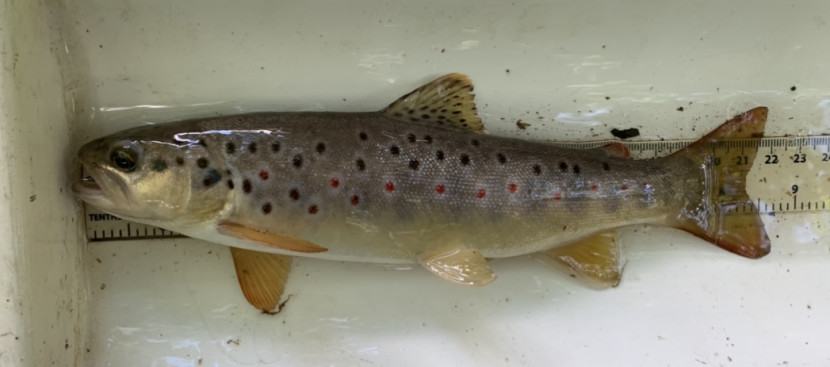 Brown Trout - EA team, Bideford Brook
Brown Trout - EA team, Bideford Brook 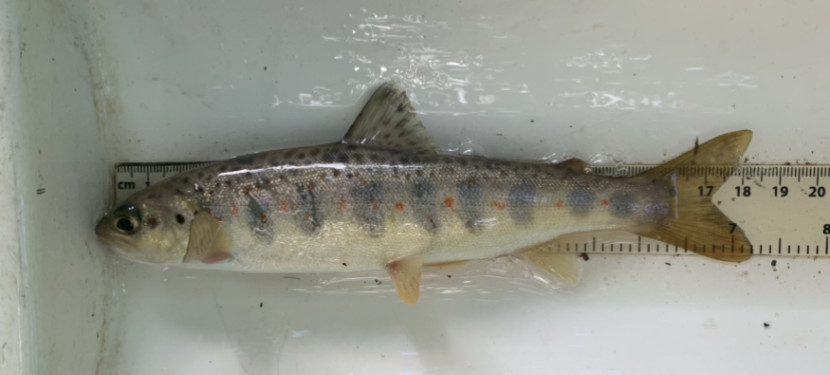 Salmon - EA team, Bideford Brook
Salmon - EA team, Bideford Brook Farmer and fishery owner Martin Penn was understandably pleased to read the report, remarking: “We must be doing something right.” I was not too surprised; we know this little stream has a prolific population of small trout, salmon parr turn up regularly and I invariably find a reasonably healthy population of invertebrates when carrying out a kick-sample for the River-fly database. The question rather should be why is it so good? Martin might have remarked that the point is that nobody upstream is doing anything wrong at the moment. I can also suggest it might be because there is no intensive agriculture upstream, but only lightly grazed pasture and mainly deciduous forest. All is not quite perfect. The upstream catchment in the Forest does include one sizeable town, Cinderford, and two villages, Soudley and Blakeney, with associated sewage treatment works, a couple of car washes and various other potential risks. I do know from previous water sampling by the EA that there are slightly high readings of certain heavy metals; this can be ascribed to the Forest’s industrial past and will not change for a very long time.
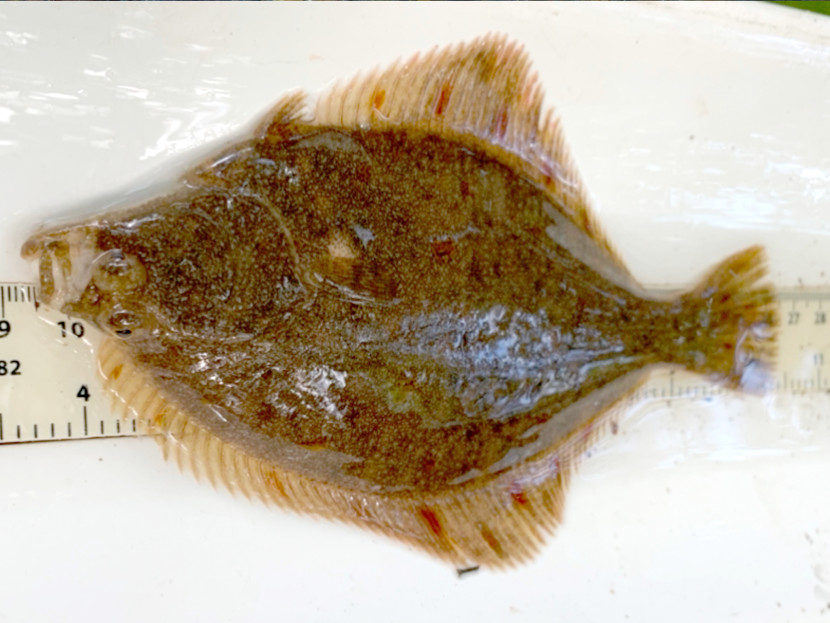 Flounder - EA team, Bideford Brook
Flounder - EA team, Bideford Brook 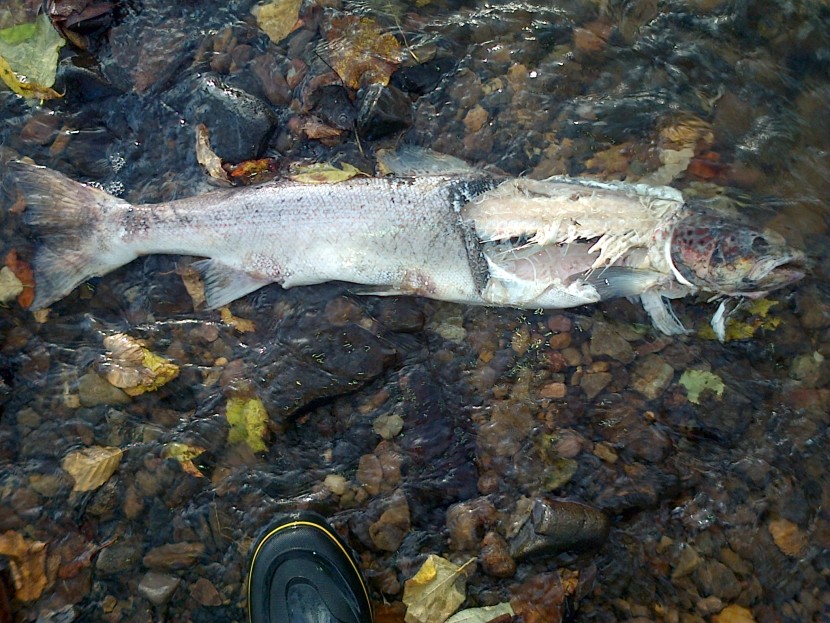 Severn salmon in Bideford Brook
Severn salmon in Bideford Brook The presence of salmon in such a small stream is always fascinating to consider. Laura makes the point that the pill (outflow to the estuary) of the Bideford Brook has no one-way flap valve to inhibit inland flooding on spring tides. It is about the only stream running into the Severn on this side which has no such obstruction – which is why the road to Awre floods on occasion. There is one low weir associated with a ruined mill below our fishing area, but a big tide overtops that and thus allows access. On the other hand, salmon cannot ascend above Blakeney, due to the old eel trap weir in the village forming a total block which even salmon cannot leap. The idea of removing that or making a salmon pass there is an old chestnut, much discussed over the years, but so far without result.
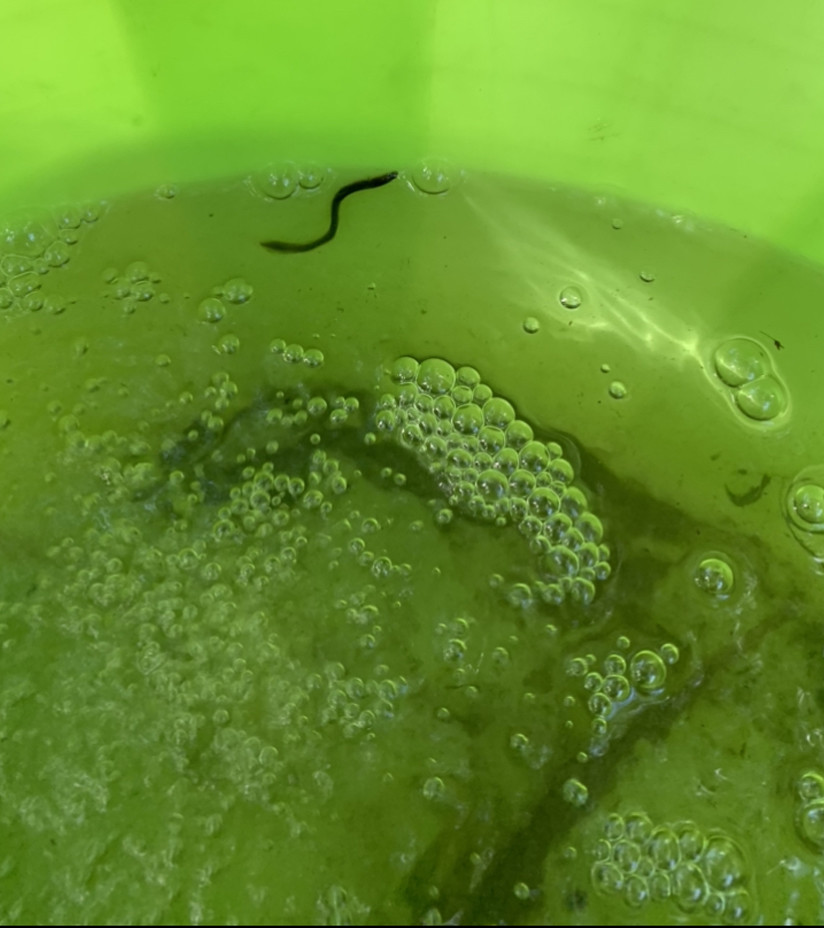 Elver - EA team, Bideford Brook
Elver - EA team, Bideford Brook 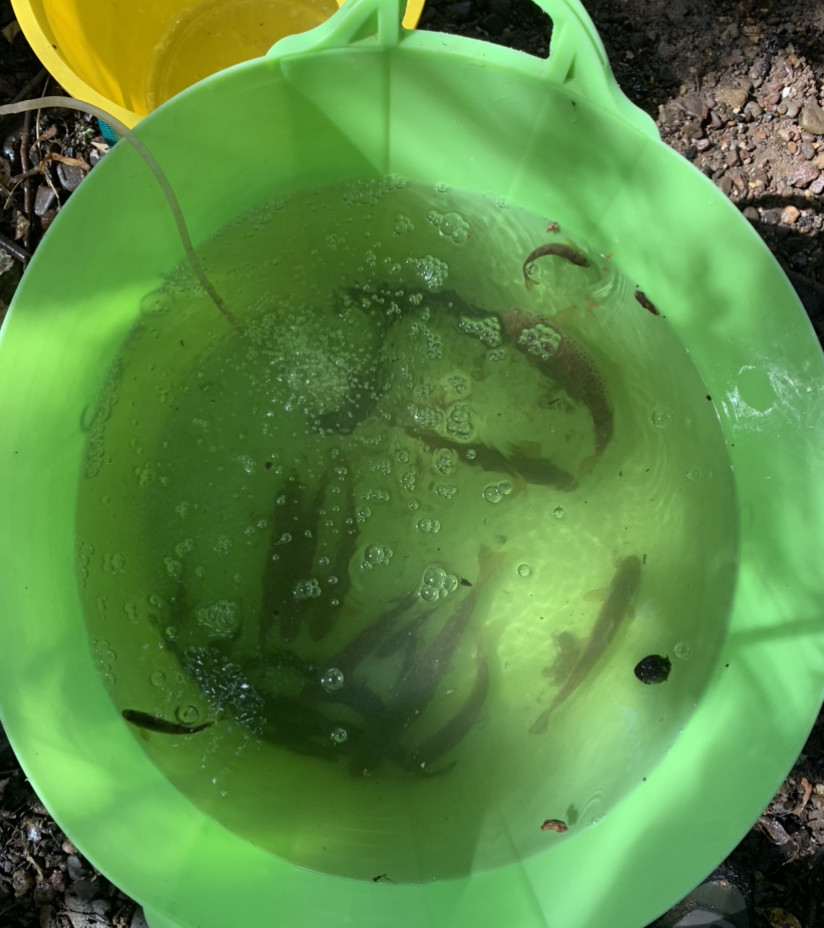 Sampled fish recovering - EA team, Bideford Brook
Sampled fish recovering - EA team, Bideford Brook August was difficult at times for game anglers, but days are shortening, nights are cooler and we have September and the grayling fishing to look forward to.
Tight lines!
Oliver Burch